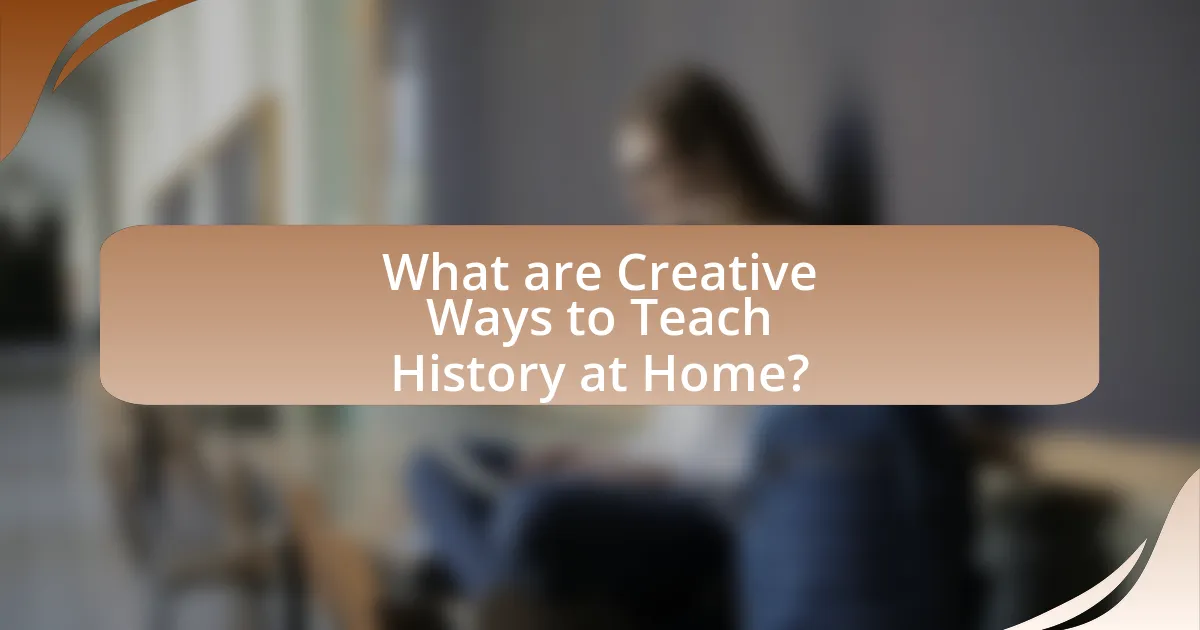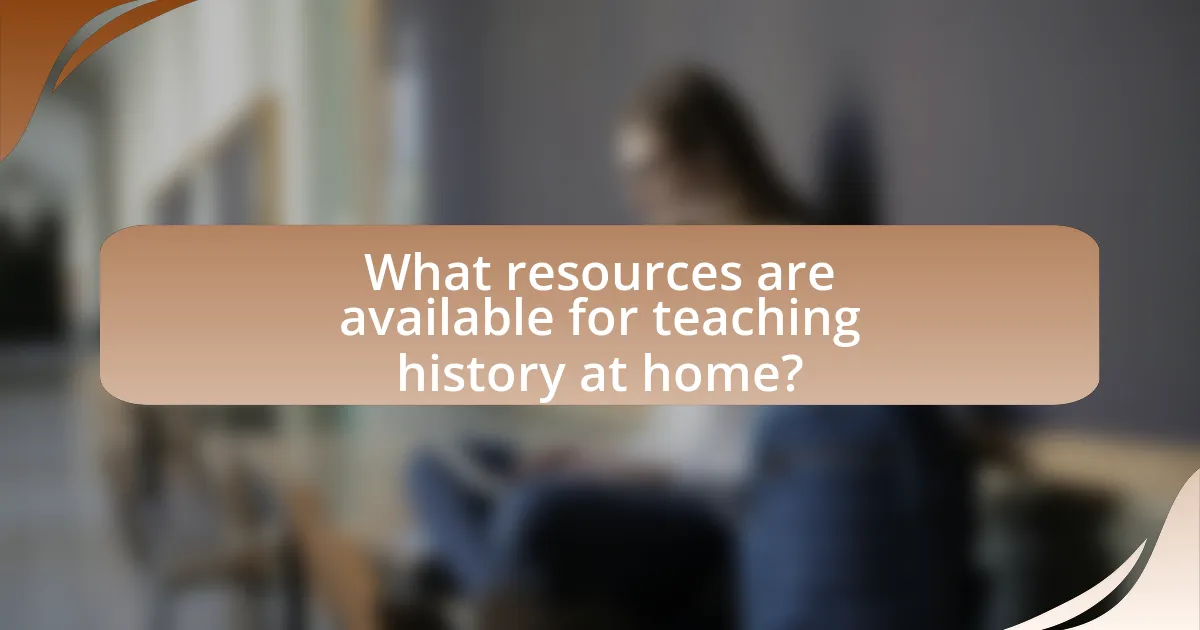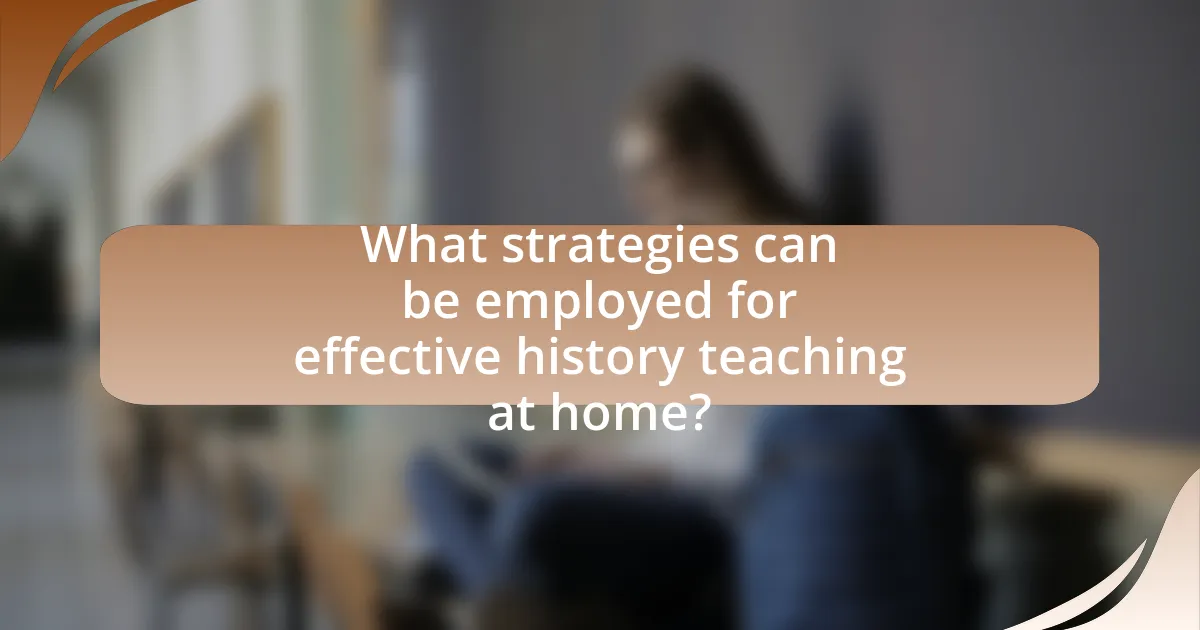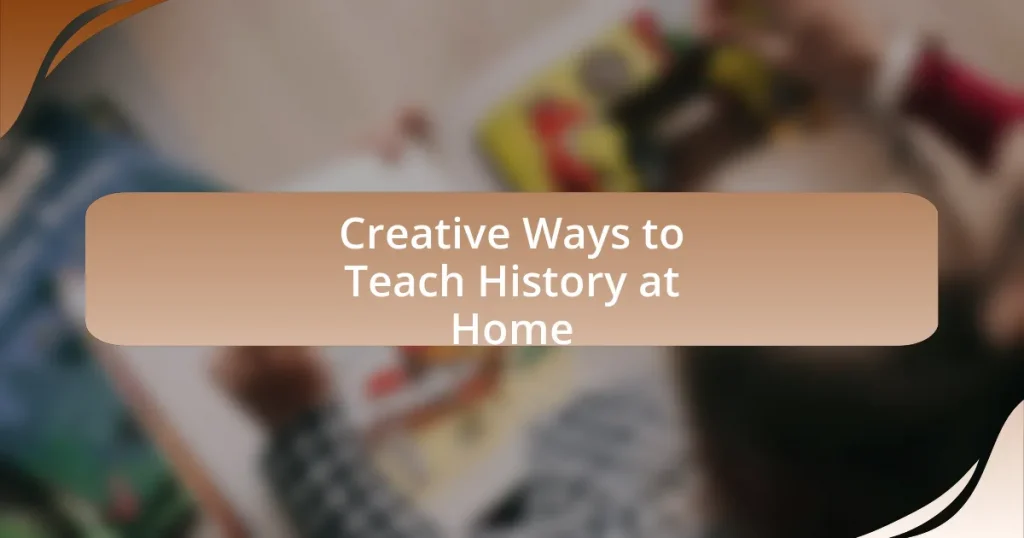The article focuses on creative ways to teach history at home, emphasizing interactive methods such as timelines, role-playing, and multimedia resources to enhance engagement and retention. It outlines strategies for parents to effectively engage children in history learning through storytelling, hands-on projects, and debates, while also highlighting the importance of experiential learning. Additionally, the article discusses various resources available for home education, including online platforms, documentaries, and recommended books, as well as best practices for creating a comprehensive history curriculum. Overall, it provides practical insights into making history education more relatable and enjoyable for learners.

What are Creative Ways to Teach History at Home?
Creative ways to teach history at home include using interactive timelines, role-playing historical figures, and incorporating multimedia resources. Interactive timelines allow learners to visualize historical events chronologically, enhancing their understanding of cause and effect. Role-playing encourages engagement by allowing students to embody historical figures, fostering empathy and deeper connections to the material. Multimedia resources, such as documentaries and podcasts, provide diverse perspectives and can make historical events more relatable and engaging. These methods have been shown to improve retention and interest in history, as they cater to various learning styles and promote active participation.
How can parents engage children in history learning?
Parents can engage children in history learning by incorporating interactive activities such as storytelling, role-playing, and hands-on projects. These methods allow children to connect emotionally and intellectually with historical events, making the learning experience more memorable. For instance, parents can encourage children to reenact historical events or create dioramas that depict significant moments in history. Research shows that experiential learning enhances retention and understanding, as children are more likely to remember information when they actively participate in the learning process.
What interactive activities can enhance history lessons?
Interactive activities that can enhance history lessons include role-playing historical events, creating timelines, and conducting debates on historical issues. Role-playing allows students to immerse themselves in historical contexts, fostering empathy and understanding of different perspectives. Creating timelines helps students visualize the sequence of events and their interconnections, reinforcing chronological thinking. Conducting debates encourages critical thinking and engagement with historical arguments, allowing students to explore various viewpoints. These activities are supported by educational research indicating that active participation significantly improves retention and comprehension of historical content.
How can storytelling be used to teach historical events?
Storytelling can be used to teach historical events by engaging learners emotionally and providing relatable contexts for complex subjects. This method allows individuals to connect with historical figures and events on a personal level, making the information more memorable. For instance, narratives about the experiences of soldiers during World War II can illustrate the realities of war, fostering empathy and understanding. Research shows that storytelling enhances retention of information; a study by the University of California found that people remember stories up to 22 times more than facts alone. Thus, storytelling serves as an effective pedagogical tool in history education.
Why is it important to teach history creatively?
Teaching history creatively is important because it enhances engagement and retention of historical knowledge among learners. Creative methods, such as storytelling, role-playing, and interactive projects, allow students to connect emotionally with historical events and figures, making the learning experience more relatable and memorable. Research indicates that students who engage in creative learning activities demonstrate improved critical thinking skills and a deeper understanding of historical contexts, as evidenced by studies showing that experiential learning can increase retention rates by up to 75%. Therefore, incorporating creativity into history education not only fosters a more dynamic learning environment but also promotes a lasting appreciation for history.
What benefits does creative teaching bring to history education?
Creative teaching enhances history education by fostering engagement and critical thinking among students. This approach allows learners to connect emotionally with historical events, making the subject more relatable and memorable. For instance, using role-playing or simulations can help students understand the complexities of historical figures and events, leading to deeper comprehension. Research indicates that active learning strategies, such as project-based learning, improve retention rates by up to 75% compared to traditional lecture methods. Thus, creative teaching not only makes history more enjoyable but also significantly boosts educational outcomes.
How does creativity in teaching history affect student retention?
Creativity in teaching history significantly enhances student retention by making the subject more engaging and relatable. When educators incorporate creative methods such as storytelling, interactive projects, and multimedia resources, students are more likely to connect emotionally with historical content. Research indicates that students who engage in creative learning experiences demonstrate improved memory retention; for instance, a study published in the Journal of Educational Psychology found that students who participated in project-based learning retained information 30% longer than those who received traditional instruction. This increased retention is attributed to the active involvement and personal investment students experience through creative teaching approaches.

What resources are available for teaching history at home?
Various resources are available for teaching history at home, including online courses, educational websites, history-themed books, documentaries, and interactive apps. Online platforms like Khan Academy and Coursera offer structured history courses that cover different periods and themes, making them accessible for learners of all ages. Educational websites such as History.com and the Smithsonian’s History Explorer provide articles, videos, and activities that engage students with historical content. Additionally, books like “A Little History of the World” by E.H. Gombrich offer narrative-driven insights into history, while documentaries from PBS and BBC present visual storytelling of historical events. Interactive apps like “Timeline – World History” allow users to explore historical timelines and events in an engaging format. These resources collectively support a comprehensive and engaging approach to learning history at home.
How can online platforms support home history education?
Online platforms can support home history education by providing access to a wide range of educational resources, including interactive lessons, documentaries, and primary source materials. These platforms, such as Khan Academy and Coursera, offer structured courses that cover various historical topics, allowing learners to engage with content at their own pace. Additionally, platforms like YouTube host educational channels that present historical events in an engaging format, making complex subjects more accessible. Research indicates that multimedia resources enhance retention and understanding of historical concepts, as they cater to different learning styles and encourage active participation.
What are the best websites for history resources?
The best websites for history resources include the National Archives, History.com, and the Smithsonian Institution. The National Archives provides access to primary source documents and educational materials, making it a valuable resource for historical research. History.com offers articles, videos, and interactive content that cover a wide range of historical topics, enhancing understanding through engaging formats. The Smithsonian Institution features a vast array of online exhibits and educational resources that explore various aspects of history and culture, providing users with rich, informative content. These websites are widely recognized for their credibility and comprehensive resources in the field of history.
How can documentaries and films be integrated into lessons?
Documentaries and films can be integrated into lessons by using them as visual aids to enhance understanding of historical events and concepts. Educators can select relevant documentaries that align with the curriculum, allowing students to engage with the material through storytelling and visual representation. For instance, a documentary on World War II can provide context and emotional depth that textbooks may lack, facilitating discussions and critical thinking. Research indicates that visual learning can improve retention rates; a study by the University of California found that students retain 65% of information when they see it in a video compared to 10% when reading text alone. This integration not only makes lessons more engaging but also caters to diverse learning styles, ultimately enriching the educational experience.
What materials can enhance the teaching of history?
Primary materials that can enhance the teaching of history include primary source documents, historical fiction books, multimedia resources, and interactive timelines. Primary source documents, such as letters, photographs, and official records, provide firsthand accounts that deepen understanding of historical events. Historical fiction books engage readers by weaving narratives around real events, making history relatable and memorable. Multimedia resources, including documentaries and podcasts, offer diverse perspectives and can cater to different learning styles. Interactive timelines allow learners to visualize the chronological progression of events, fostering a clearer understanding of cause and effect in history. These materials collectively enrich the learning experience and promote critical thinking about historical contexts.
Which books are recommended for teaching history at home?
Recommended books for teaching history at home include “A Little History of the World” by E.H. Gombrich, which provides a concise overview of world history in an engaging narrative style. Another excellent choice is “The Story of the World” series by Susan Wise Bauer, which presents history as a continuous story, making it accessible for children. Additionally, “History for Kids: The Ancient World” by David Stokes offers age-appropriate insights into ancient civilizations. These books are effective because they combine storytelling with factual information, making history relatable and interesting for learners.
How can art supplies be used to create historical projects?
Art supplies can be used to create historical projects by enabling hands-on learning experiences that illustrate historical events, figures, and cultures. For instance, students can use paints, clay, and paper to recreate historical artifacts, such as ancient pottery or famous paintings, which helps them understand the significance of these items in their respective contexts. Additionally, art supplies can facilitate the creation of dioramas or timelines that visually represent historical narratives, allowing learners to engage with the material in a tangible way. This method aligns with educational research indicating that active participation in learning enhances retention and comprehension of historical content.

What strategies can be employed for effective history teaching at home?
Effective history teaching at home can be achieved through interactive storytelling, utilizing primary sources, and incorporating multimedia resources. Interactive storytelling engages learners by making historical events relatable and memorable, as seen in the use of narratives that connect personal experiences to broader historical contexts. Utilizing primary sources, such as letters, photographs, and official documents, allows students to analyze authentic materials, fostering critical thinking and a deeper understanding of historical events. Incorporating multimedia resources, including documentaries, podcasts, and educational games, enhances engagement and caters to various learning styles, making history more accessible and enjoyable. These strategies collectively create a dynamic learning environment that promotes active participation and critical analysis of historical content.
How can parents create a history curriculum at home?
Parents can create a history curriculum at home by selecting specific historical themes or periods to focus on, such as ancient civilizations, the American Revolution, or world wars. They can utilize a variety of resources, including books, documentaries, online courses, and interactive websites, to provide diverse perspectives and engaging content. For example, the National Archives offers primary source documents that can enhance understanding of historical events. Additionally, parents can incorporate hands-on activities like reenactments, field trips to historical sites, or projects that encourage critical thinking about historical contexts. This approach not only fosters a deeper understanding of history but also makes learning interactive and enjoyable.
What key elements should be included in a home history curriculum?
A home history curriculum should include key elements such as chronological timelines, thematic studies, primary source analysis, and local history exploration. Chronological timelines help students understand the sequence of historical events, while thematic studies allow for deeper exploration of specific topics like civil rights or technological advancements. Primary source analysis engages students with original documents, fostering critical thinking skills. Local history exploration connects students to their community’s past, making history more relatable and relevant. These elements collectively enhance the learning experience by providing a comprehensive and engaging approach to history education at home.
How can parents assess their child’s understanding of history?
Parents can assess their child’s understanding of history by engaging them in discussions about historical events and asking open-ended questions. This method allows parents to gauge their child’s comprehension and critical thinking skills regarding historical narratives. For example, parents can ask their child to explain the significance of a specific event, such as the American Revolution, and encourage them to connect it to contemporary issues. Additionally, parents can utilize quizzes or interactive activities, such as timeline creation or role-playing historical figures, to evaluate their child’s retention of historical facts and concepts. Research indicates that active engagement in learning enhances retention, making these methods effective for assessment.
What are some tips for making history lessons fun and engaging?
Incorporating interactive activities is essential for making history lessons fun and engaging. Activities such as role-playing historical figures or reenacting significant events can enhance students’ understanding and retention of historical concepts. For example, a lesson on the American Revolution can be made more engaging by having students act out debates between patriots and loyalists, which fosters critical thinking and empathy. Additionally, using multimedia resources like documentaries or virtual museum tours can captivate students’ attention and provide a richer context for historical events. Research shows that active learning strategies, such as these, significantly improve student engagement and comprehension in history education.
How can games and simulations be used in history education?
Games and simulations can be used in history education by providing immersive experiences that engage students in historical events and contexts. These interactive tools allow learners to explore complex historical scenarios, make decisions, and see the consequences of their actions, thereby enhancing critical thinking and empathy. For instance, simulations like “The Oregon Trail” teach about westward expansion in the United States by placing players in the role of pioneers facing real-life challenges. Research indicates that such experiential learning methods improve retention of historical facts and concepts, as evidenced by a study published in the “Journal of Educational Psychology,” which found that students who participated in simulations scored significantly higher on assessments of historical knowledge compared to those who learned through traditional lectures.
What role does field trips play in teaching history at home?
Field trips play a crucial role in teaching history at home by providing experiential learning opportunities that enhance understanding and retention of historical concepts. Engaging with historical sites, museums, or reenactments allows learners to connect with the past in a tangible way, making history more relatable and memorable. Research indicates that experiential learning can improve knowledge retention by up to 75%, compared to traditional classroom methods. This hands-on approach fosters critical thinking and encourages discussions about historical events, thereby enriching the educational experience at home.
What common challenges do parents face when teaching history at home?
Parents commonly face challenges such as a lack of resources, difficulty in engaging their children, and the complexity of historical narratives when teaching history at home. The lack of resources can hinder parents from accessing diverse materials that make history relatable and interesting. Engaging children is often difficult due to their varying interests and attention spans, which can lead to disinterest in historical topics. Additionally, the complexity of historical narratives, including differing perspectives and interpretations, can confuse both parents and children, making it challenging to convey accurate and comprehensive historical knowledge.
How can parents overcome resistance to learning history?
Parents can overcome resistance to learning history by making the subject engaging and relevant through interactive activities. Incorporating storytelling, hands-on projects, and multimedia resources can capture children’s interest and illustrate historical events in a relatable manner. For example, using historical fiction books or documentaries can provide context and emotional connection to the material. Research shows that active learning strategies, such as role-playing historical figures or visiting historical sites, enhance retention and understanding, making history more appealing to students.
What strategies can help maintain a child’s interest in history?
Engaging a child’s interest in history can be effectively achieved through interactive storytelling and hands-on activities. Interactive storytelling allows children to connect emotionally with historical events, making them more relatable and memorable. For instance, using historical fiction books or documentaries that dramatize events can spark curiosity and discussion. Hands-on activities, such as creating timelines, reenacting historical events, or visiting historical sites, provide tangible experiences that reinforce learning. Research indicates that experiential learning enhances retention and understanding, as children are more likely to remember information when they actively participate in the learning process.
What are the best practices for teaching history creatively at home?
The best practices for teaching history creatively at home include using interactive storytelling, incorporating multimedia resources, and engaging in hands-on projects. Interactive storytelling allows learners to connect emotionally with historical events, making them more memorable. For instance, reenacting historical events or using role-playing can deepen understanding. Incorporating multimedia resources, such as documentaries, podcasts, and virtual museum tours, provides diverse perspectives and enhances engagement. Hands-on projects, like creating timelines or building models of historical sites, foster creativity and critical thinking. These methods align with educational research indicating that active learning strategies improve retention and comprehension in history education.










